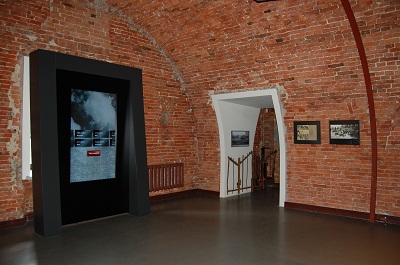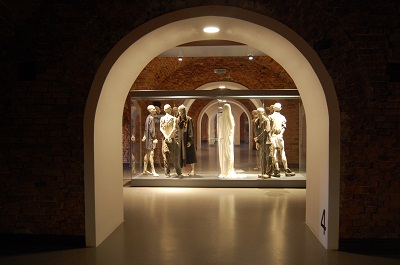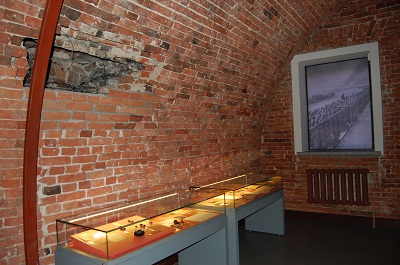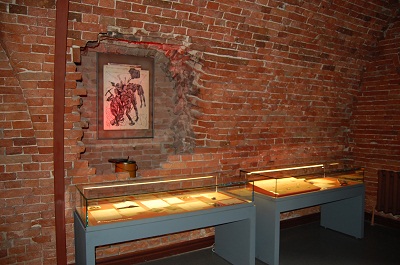Hall 3. «Challenge»
The tragedy of the war was not only in death, sufferings and separation of millions of people. For a lot of them captivity became a heavy challenge. The Brest garrison soldiers were one of the first to experience fascist captivity. Only few of them came back to the Homeland, keeping a lifetime memory about the things that they lived through.

Left from the caponier entrance you can see a German picture, which shows soviet prisoners of war burying their comrades in a crater from the “Carl” mortar artillery shell. In 2011, excavations in the area of the fortress church have been performed by the 52nd separate specialized battalion from the Ministry of Defense of Belarus. These excavations discovered the remains of 58 people. Only 3 of those people have been identified. On the wall left from the caponier entrance there is a page from the German magazine “Signal”, #15 from August 1941 (written in French), where the pictures of the Brest Fortress war prisoners are displayed. The pictures are followed by the comments: “white rags in their raised hands, the last soviet soldiers are leaving the fortress. They need to keep this position until they get unarmed. We had to take such precautions, since it happened before that Red Army soldiers were showing white-colored things, but soon after were shooting German soldiers, as they were approaching closer…”. On the 22nd of June 1941, the first echelon with soviet prisoners of war, the Brest Fortress defenders, arrived to the city of Biala Podlaska (Stalag #307, Poland). Most of the arrived went through this camp, but soon after it was disbanded in the end of September – beginning of October 1941. Then, the prisoners have been transformed to different camps in Germany and other countries under its occupation.

The image of captivity and sending prisoners to camps is symbolized by the wagon-showcase in the center of the hall. Inside this showcase you can see mannequins wearing prisoner clothes from different camps: striped clothing and stocks, riding-breeches, helmet with visor from the Maidanek concentration camp (Poland), the greatcoat of the soviet war prisoner G. Blankovsky with the sign “SU” from the Zeithain concentration camp (Germany). The woman figure in the middle of the wagon symbolizes the mourning about the women that died staying captive and the women that lost their close ones during the war.

The real wagons used for prisoners’ transportation were the freight ones and had no roof. Despite the time of the year (winter or summer), hundreds of people used to be transported by such wagons. A lot of them could no t take hard conditions like that and were dying before reaching the final destination. On the windows on the left you can see pictures of wagons carrying the prisoners of war. One of those pictures is taken on the Brest railway station. In the showcases of the left half of the hall one can find different materials about the ones that got to the camp-revere (infirmary) which was formed in the Southern town. Around 15 thousands of people died there from wounds and serious illnesses. The remains of those people are staying there until nowadays. The fates of some specific medics taken captive have a special meaning, since they made it their human and civic duty to save lives of wounded, ill and haggard prisoners. Those people are: surgeons B. Maslov, I. Makhovenko, Y. Petrov, V. Zanin, paramedic V. Chelobanov, medical instructor V. Solozobov. In the right half of the hall the prisoners’ record-card examples are presented. Some of the exhibits in the hall tell the stories about the ones that attempted to escape captivity and those people who helped them in different countries.

Besides the escape attempts, the underground anti-fascist activities were another form of resistance. One of the examples and symbols of such struggle is an uprising in the Buchenwald concentration camp on the 11th of April 1945. The story of this event is being told by the materials from the right half of the hall: the picture of one of the uprising leaders; the picture of N. Kueng, one of the defendants, the plan of the uprising, the model of underground radio, the picture called “The fragment of Buchenwald prisoners’ uprising” and the model of Buch-2 grenade. Such grenades and radios have been used by the insurgent. Personal numbers of prisoners from different camps serve as a reminder about the inhuman treatment and full individuality humiliation in captivity. Prisoners have been deprived from the most precious things, even the names, which were replaced by numbers. The terrible captives’ destruction machine was functioning through the system of concentration camps, camps of death and prisons. A lot of them were built in Germany even before its attack on the Soviet Union. Subsequently, a chain of such camps appeared on the whole occupied territory. The interactive map on the touchpad in the right half of the hall gives the idea about the location and the number of camps. Prisons, concentration camps, camps of death, and working camps on the German and other occupied territories are marked with black dots. 33 camps that captivated the Brest fortress defenders are marked with red triangles. They also contain the information about each camps itself, the pictures of camps and prisoners, the lists of their names and the memories of those who stayed alive.
